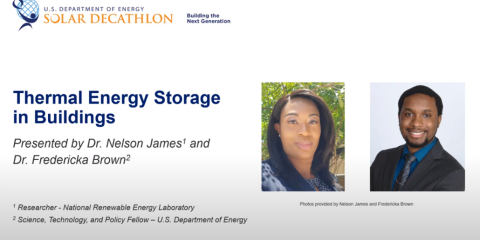This webinar was originally presented by Amber Wood as part of the 2019 Design Challenge. In this webinar, Amber discusses REM/Rate, a home energy rating tool.
Resource Library
Showing results 341 - 360 of 397
Using knowledge on heat pumps and HVAC systems from previous videos in this module, this episode dives deeper into the sample calculations for reducing the electrical load on a residential building.
This video explains the impact of design decisions, the importance of setting goals, and how measurable goals can lead to more successful building design.
This video explains the concepts of site energy and source energy. After introducing the conversion factors for source energy consumption, this video goes through 2 example calculations for zero energy balance.
This webinar, originally presented as part of the 2020 Solar Decathlon Webinar Series, discusses photovoltaic (PV) systems, the most common way for a building to generate renewable energy.
This video discusses weather data, including heating degree days and cooling degree days, and how this information is used to inform the ΔT term in the Fourier's Law equation.
In this episode, we discuss the cost of zero energy buildings and where the cost lands in relation to the average builiding in the U.S.
In this video, guest speaker Marc LaFrance, Windows Technologies Manager for the US Department of Energy, discusses advanced window technologies in buildings.
This video addresses ways to produce hot water and the energy impacts of using hot water in a building.
This video is presented by Dr. Nelson James, Researcher at the National Renewable Energy Lab, and Dr. Fredricka Brown from the US Department of Energy Building Technologies Office. Together, they discuss the motivations behind pursuing energy storage, how these technologies works, and the future of...
This first video in the HVAC module focuses on defining the efficiency of a heating system and ways to reduce the amount of energy purchased for a heating system.
This video discusses ways of bringing fresh air into buildings through ventilation and the energy consequences associated with doing so.
In this video, we will discuss the most common technologies for heating water, including storage, tankless, heat pump, and solar water heaters. We will also discuss best practices for saving energy with water heating systems.
This webinar, titled "What is Good Design?," was originally presented by the US Department of Energy's Sam Rashkin as part of the 2019 Design Challenge. In this webinar, Rashkin discusses how to consistently provide good designs for projects.
In this video, we discuss plug process and other miscellaneous loads in a building, and why they are an important part of the design problem.
The fraction of solar radiation admitted through a window is characterized by? (a) Visible Transmittance (b) Solar heat gain coefficient (c) Light-to-solar gain (d) None of the above
Design strategies for systems where a heat pump is being added as a partial load, instead of the whole system. Details the benefits and shows cost saving calculations. Target audience is heat pump installers.
These lecture notes provide information about sizing an HVAC system.
True or False: It’s better to have a central air-conditioning system that's too large than to have a homeowner complain about being uncomfortable at the hottest time of year. a. True b. False
Video describing a technique to insulate walls to a higher R-value using a foam board on the exterior side.












